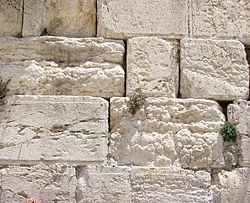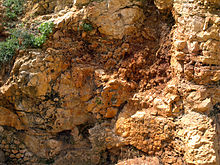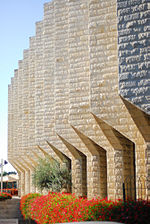- Jerusalem stone
-
 Jerusalem stone (Western Wall, Jerusalem)
Jerusalem stone (Western Wall, Jerusalem)
Jerusalem stone (Hebrew: אבן ירושלמית, even yerushalmit) is a name applied to various types of pale limestone, dolomite and dolomitic limestone, common in and around Jerusalem that have been used in building since ancient times. One of these limestones, meleke, has been used in many of the region's most celebrated structures, including the Western Wall.
Jerusalem stone continues to be used in construction and incorporated in Jewish ceremonial art such as menorahs and seder plates. In 2000, there were 650 stone-cutting enterprises run by Palestinians in the West Bank, producing a rich range of pink, sand, golden, and off-white bricks and tiles.[1]
Contents
Geology
The highlands of Judea and Samaria are primarily underlain by sedimentary limestone, dolomite and dolomitic limestone. The stone quarried for building purposes, ranging in color from white to pink, yellow and tawny, is known collectively as Jerusalem stone.
- Soft Senonian limestone is found to the east of Jerusalem, and has long been used as an inexpensive building material.[2]
- Stone of the Cenomanian layers, known in Arabic as mizzi ahmar and mizzi yahudz, is far more durable than Senonian limestone, but is very hard and was expensive to quarry using pre-modern methods.[2]
- Turonian layers yield mizze helu and meleke, the most prized building stones.[2] The thin layered mizze helu is easily quarried and worked. Meleke is soft and easy to chisel, yet hardens with exposure to the atmosphere and becomes highly durable.[2] It was used for the great public buildings of antiquity,[3] and for the construction of the Islamic period city walls and buildings.
The remains of ancient quarries can be seen near Yemin Moshe, in the Sanhedria neighborhood, and elsewhere.[2]
Use in building
Municipal laws in Jerusalem require that all buildings be faced with local Jerusalem stone.[4] The ordinance dates back to the British Mandate and the governorship of Sir Ronald Storrs[5] and was part of a master plan for the city drawn up in 1918 by Sir William McLean, then city engineer of Alexandria.[6]
According to a report by the Geological Survey of Israel:
The various rock types in the area were exploited for different purposes.The variety of lithologic types used in building are:
1. White, coarse crystalline limestone originally referred to as "Meleke", the stone of Kings.
2. Cream-colored micritic limestone known locally as "Mizzi Hilu" (sweet rock).
3. Red-colored limestone known as "Mizzi Ahmar" (red rock).
4. Gray crystalline dolomite known as “Mizzi Yehudi” (Jewish rock – modern times).
5. Flagstone of thin-layered limestone.
These rock types were quarried from the Judean limestone and dolomite in and around the Old City of Jerusalem.[7] This variety of stone gives Jerusalem its unique character. The setting sun reflected on the cream-colored limestone facade of both ancient and modern structures gives them a golden hue, giving rise to the term "Jerusalem of Gold".[8]Symbolic use
The various "Jerusalem stones" are employed worldwide in Jewish buildings as a symbol of Jewish identity.[9][10] It has been used this way in many Jewish community centers, including the one in San Jose, Costa Rica,[11] in Hillel buildings such as the Columbia/Barnard Hillel building, in Jewish memorials including the Holocaust Memorial on Miami Beach, in many Jewish schools including the Charles E. Smith Jewish Day School in Rockville, Maryland and in numerous synagogues, including the 1901 Ades Synagogue in Aleppo, Syria, the Village Shul in Toronto and the new Jewish Chapel at the United States Naval Academy, in Annapolis, Maryland.
Other buildings use Jerusalem stone in a symbolic manner. Thus the 1855 building of Congregation Baith Israel Anshei Emes in Brooklyn, New York has elements painted in a trompe-l'œil manner to look like Jerusalem stone, and Congregation Agudas Achim in Austin, Texas has walls of Texas limestone designed to evoke Jerusalem stone. Some Christian institutions, including the Upper Room Prayer and Worship Center in Saint Joseph, Missouri use Jerusalem stone to evoke Jerusalem.
Churches have used Jerusalem stone in a similar manner. A Pentecostal church in São Paulo, Brazil recently ordered $8 million worth of Jerusalem stone to construct a Replica of the Temple of Solomon, or Templo de Salomão that will stand 180 feet tall.[12]
Suppliers
In 1923, Aharon Grebelsky established the country's first Jewish-owned marble quarry in Jerusalem. Grebelsky's son Yechiel expanded the business, employing over 100 workers, including quarriers, stonemasons, fabricators and installers. Today, the company is a major exporter of Jerusalem stone and a leading supplier to the North American market. It inaugurated a new, state-of-the-art factory in Mitzpe Ramon in January 2000. [13]
References
- ^ Palestinians' stones cut both ways Ilene Prusher, The Christian Science Monitor, January 4, 2000
- ^ a b c d e Influence of Geological Conditions on the Development of Jerusalem, M. Avnimelech, Bulletin of the American Schools of Oriental Research, No. 181 (Feb., 1966), pp. 24-31
- ^ Ashlar Quarries of the Iron Age in the Hill Country of IsraelAshlar Quarries of the Iron Age in the Hill Country of Israel, Yigal Shiloh, Aharon Horowitz, Bulletin of the American Schools of Oriental Research, No. 217 (Feb., 1975), pp. 37-48
- ^ Passion Set in Stone, New York Times, Sept. 10, 1995
- ^ Jerusalem Architecture Since 1948
- ^ The British Mandate from "Jerusalem: Life Throughout the Ages in a Holy City". Online course material from the Ingeborg Rennert Center for Jerusalem Studies, Bar-Ilan University, Ramat-Gan, Israel
- ^ Holy Land’s ‘Jerusalem stone’ cements base of U.S. buyers, Denver Business Journal
- ^ Arkin, Yaacov and Amos Ecker (2007), “Report GSI/12/2007: Geotechnical and Hydrogeological Concerns in Developing the Infrastructure Around Jerusalem”, The Ministry of National Infrastructures, Geological Survey of Israel, Jerusalem, Israel, July, 2007
- ^ Defining Jewish identity, Architectural Review, June, 2005 by Layla Dawson [1]
- ^ "ART/ARCHITECTURE; What Design For a Synagogue Spells Jewish?," By PHILIP NOBEL, December 2, 2001, New York Times, [2]
- ^ Jerusalem Stone forms a haven in Costa Rica, Reflecting the spirit of Israel, a large quantity of Jerusalem Stone was used for a new Jewish Community Center in San Jose, Costa Rica, Stone World, 19 November 2005 [3]
- ^ "Solomon's Temple in Brazil would put Christ the Redeemer in the shade; Huge replica planned for Sâo Paulo would be twice the height of the iconic statue of Jesus in Rio de Janeiro Tom Phillips, July 21, 2010, The Guardian.
- ^ Supplying the world with Jerusalem stone
See also
Wikimedia Foundation. 2010.


